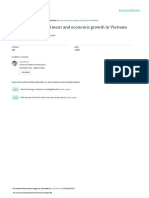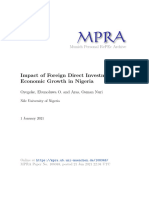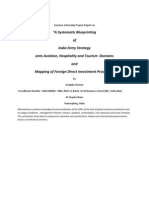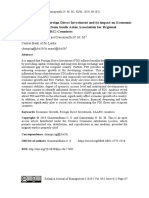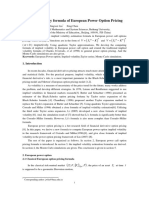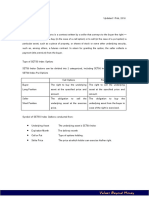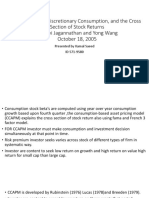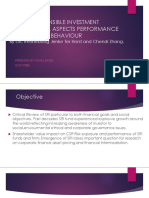Foreign Direct Investment and Gross Domestic Product: An Application On ECO Region (1995-2011)
Foreign Direct Investment and Gross Domestic Product: An Application On ECO Region (1995-2011)
Uploaded by
Adnan KamalCopyright:
Available Formats
Foreign Direct Investment and Gross Domestic Product: An Application On ECO Region (1995-2011)
Foreign Direct Investment and Gross Domestic Product: An Application On ECO Region (1995-2011)
Uploaded by
Adnan KamalOriginal Description:
Original Title
Copyright
Available Formats
Share this document
Did you find this document useful?
Is this content inappropriate?
Copyright:
Available Formats
Foreign Direct Investment and Gross Domestic Product: An Application On ECO Region (1995-2011)
Foreign Direct Investment and Gross Domestic Product: An Application On ECO Region (1995-2011)
Uploaded by
Adnan KamalCopyright:
Available Formats
International Journal of Business and Social Science
Vol. 3 No. 22 [Special Issue November 2012]
Foreign Direct Investment and Gross Domestic Product: An Application on ECO
Region (1995-2011)
Assist. Prof. Dr. Ali Rza SANDALCILAR
Recep Tayyip Erdoan University
Faculty of Economics and Administrative Sciences
Department of Economics
Rize, Turkey
Res. Assist. Ali ALTINER
Recep Tayyip Erdoan University
Faculty of Economics and Administrative Sciences
Department of Economics
Rize, Turkey
Abstract
Theoretical studies reveal that Foreign Direct Investments (FDI) have a positive impact on the growth in GDP of
the host-country. This study puts forward whether the relationship between FDI inflow and GDP in the region of
Economic Cooperation Organization (ECO) is coherent with the theoretical expectations. In this framework, the
causal relationship between FDI inflow to the ECO region and GDP will be analyzed. The data of 1995-2011
periods is used in causality analysis covering ten ECO member countries. Granger Causality Test based on error
correction model and Holtz-Eakin, Newey and Rosen Panel Causality Test are applied in analysis. According to
the results of the causality tests, a strong positive causality from FDI to GDP and a slightly less positive causality
from GDP to FDI in ECO region have been detected. Obtained results of the study comply with the theoretical
expectations.
Keywords: Foreign Direct Investment, Economic Growth, GDP, ECO, FDI
JEL Codes: E22, F20, F21, O16
1. Introduction
Enhancing per capita income within a country through increasing current output level constitutes one of the
primary objectives of economics. The close relationship between GDP, current output level and per capita income
orients economists to elaborate on the problem of how to increase these values more. The main concern in this
issue is to ensure an increase in GDP. In other words, an increase in GDP, the market value of all the products and
services produced annually within a country, can also be defined as economic growth. What is desirable in an
economy is to increase GDP and achieving economic growth consequently.
Domestic sources can be thought as the prior supplier for the capital necessary for increasing economic growth.
However, in case of low level of income and absence of enough saving, foreign investment is one of the means
for closing capital deficit (Ylmazer, 2010:242). Foreign investment is the movement of capital funds from one
country to another and realizes in the form of international money, capital markets and direct investments
(Kurtaran, 2005:367). Foreign Direct Investment (FDI) is the establishment of a new production line or buying an
already established production line in a country different from its origin with the aim of diffusing its production
abroad (Seyidolu, 1999: 664). The main influence of FDIs in a hosting country is their absolute contribution to
national income. Since the foreign capital is used in domestic production, it is added to the GDP. The issue of
attention at this point is the fact that whether the all factors used in production is produced by the owners of
capital or not. If there are imported production factors, their value should be excluded from the GDP (Karluk,
2009: 691). Type and function of the coming FDI gain importance in this sense.
189
The Special Issue on Arts, Commerce and Social Science
Centre for Promoting Ideas, USA
www.ijbssnet.com
The importance of FDIs has increased almost in all countries with the globalization process intensified with 1980s
due to their positive impact on economic growth. Therefore, its entrance has been promoted. Especially with mid1990s, FDI has been seen as a means for compensating absence of enough domestic capital. By this way, while
the total amount of FDI in 1990 was 207 billion dollar; it reached to 1,524 trillion dollar in 2011 (UNCTAD,
2012: 24).
The relationship between FDI and GDP within the region of Economic Cooperation Organisation (ECO) will be
analysed in this study by means of panel causality method. The study composes of four parts except the
introduction part. In this scope, the relation between FDI and GDP will be examined within its theoretical
framework firstly; in the succeeding part, a summary of the studies related to the issue will be provided. The
fourth part will present some basic information regarding the ECO area. Data set, method of study, analysis, and
results will be stated in the fifth part. The last part composes of a conclusion and discussion.
2. Relationship between FDI and GDP
The amount of domestic savings, capital stock, use of advanced technology and the amount of investment are
widely accepted as the key determinants of economic growth. In case of absence of enough capital stock, low
savings, inability of using technological innovations in combination with human capital; it can be argued that
there is not a fertile environment for making investments in such an economy. Hence, an increase in output level
and economic growth cannot be achieved in such a setting. The countries suffering from low levels of savings and
capital are facing with choice between finding foreign debt and to increase FDI inflow. Despite the positive
influence of foreign debt in terms of capital inflow, it bears some risks of repayment. Therefore, it is less
preferable than FDIs. It is opted, especially when there is not any or enough FDI inflow. In this scope, FDI has
been started to be seen as a fundamental source of external financing both in developed countries and countries
suffering from low capital in the last 20 years thanks to its positive effects in host country through level of capital,
technology and other means. Many developing countries are trying to attract FDI by following outward-oriented
industrialization policies in order to increase the growth of economy (Ylmazer, 2010:242). China, Brazil, Russia,
Singapore and India can be listed as the primary countries attracting huge amounts of FDI in recent years (Davies,
2010).
Economic growth theories puts forth that FDIs have positive impact on economic growth. Transfer of capital and
technology is widely accepted positive effects of FDI. But, there are also others, namely: increasing marginal
capital efficiency, efficient distribution of sources, efficiency increase, organizational skills, know-how, skilled
labour, brand, easy entrance to markets, etc. (Berthelemy and Demurger, 2000:140; Mencinger, 2003:491;
Lyroudi et. al, 2004:198; Athukorala,2003:4). Despite the theoretical consensus on positive effects of FDI on
economic growth, there is not any empirical consensus on the effects of FDIs. According to the results derived
from some sectoral studies, FDIs have no impact on economic growth. In these studies, any positive externality
between domestic and foreign firms could not have been found (Carcovic and Levine, 2002:196). While some
macroeconomic studies were not identified any positive relation between FDI and economic growth, some others
argued that the positive impact of FDIs on economic growth depends on level of income, human capital, situation
of financial system and trade policies in host country (Demirel, 2006:111). Countries, especially the developing
ones, see FDIs as a fundamental means for achieving economic growth. The governments of the countries in
which positive impacts of FDI on economic growth detected have made regulations such as tax incentives,
infrastructure incentives, and exemptions from import duties in order to enhance FDI inflow (Lyroudi et. al,
2004:198). Despite the ambiguity in the results of empirical studies, especially developing countries have making
politic regulations aiming to increase FDI inflow in order to ensure or increase economic growth by compensating
negative effects of low capital accumulation, low domestic savings, absence of use of new technology.
The theoretical structure of empirical studies about FDI and economic growth is based on the neo-classical
growth models or endogenous growth models. According to the groups defending financial liberation within the
framework of neo-classical theory, international capital flows ensure economic growth in the long run through
enhancing use of sources in the economy and increasing savings and production-oriented investments. According
to neo-classical growth models, while FDIs increase level and efficiency of investments; its impact on economic
growth is temporary in the middle-run and permanent in the long-run. Economic growth in the long-run can be
seen as a function of technological improvements in new endogenous growth models.
190
International Journal of Business and Social Science
Vol. 3 No. 22 [Special Issue November 2012]
Accordingly, FDI increases economic growth of host country through the effects of technology transfer and
diffusion (nsel and Sungur, 2003:4; Nair-Reichert and Weinhold, 2000:3). In contrast to conventional economic
growth theories, new economic growth literature pays more attention on technological developments. In this
scope, economic growth depends heavily on prevailing technological conditions in the country. It is also argued
that economic growth in developing countries is stated in terms of grasping technological developments. Besides,
a strong complementary relationship between FDI and human capital has been found; therefore, it is thought that
FDIs in relation with the increases in human capital will increase economic growth in a greater ratio (Boresztein
et. al, 1998: 118).
The most important impact of FDIs is their net contribution to host country income. FDIs influence over host
countrys economy can be analyzed by two channels. The first is the contribution of FDIs to the sector of
intermediate goods which is also defined as growth effect and the increasing specialization of input producers by
this way. The second is the externality effect stemming from R&D activities. Thus, domestic firms can benefit
from advanced knowledge of foreign enterprises (Berthelemy and Demurger, 2000:141). FDIs can be evaluated
by treating them as a special kind of capital transfer. Accordingly they have two characteristics: Firstly, FDIs may
enhance competitiveness of host country by bringing specialization and know-how. Secondly, FDIs directed
to industrial sectors may be seen as a transfer of capital between capital sectors of two countries (Karluk,
2009:688). Briefly, positive influences of FDIs on production factors in industrial sectors make a direct impact on
economic growth. According to the studies performed, FDIs make contribution to capital accumulation in host
country, ensure training and hence specialization of labour force, increase entrepreneurship skills and enable
better use of natural sources. What is more, one of the features that differentiate FDIs from other investments is
the fact that FDIs have a control power on the management policy and decisions of the business (Moosa, 2002:2).
3. Review of Literature
The relation between FDI and economic growth is frequently studied both theoretically and empirically. There are
ongoing studies especially on the economic effects of FDI in developing countries. A consensus has not been
developed yet regarding the results of analyses. Summary of some selected studies will be provided below.
Borenszteinet. al (1998), the study aims to measure the effect of FDI on economic growth in 69 developing
countries in the period of 1970-79 and by using regression bound to panel data. According to the results, it has
been seen that FDIs is a means of technology transfer contributing a lot to the economic growth. However, FDIs
have positive effect on economic growth, when advanced technology is accompanied by capital and human
capital at a certain level.
Nair-Reichert et. al (2000), they tested the causality between FDI and economic growth in 24 developing
countries within the period of 1971-1995 by using fixed effects and random effects panel data estimation method.
In consequence of econometric analysis, they founded that the effect of FDI on economic growth varies across
developing countries. Despite the differences among countries, the results show that the effect of FDI on
economic growth is higher in open economies.
Carcovic and Levine (2002), they examined the relation between FDI and economic growth in 72 countries within
the period of 1960-1995 by using new statistical techniques and two new databases. Firstly, they formed a panel
data set linked to World Bank data set and basing on the averages of seven five-year periods between 1960 and
1995. Besides, the results were verified by using the FDI data received from IMF database. Methodologically,
Generalized Method of Moments (GMM) was used. According to the results of empirical applications, it has been
seen that FDI do not have an effect on economic growth solely.
Chowdhury and Mavrotas (2003), they used an innovative econometric method in order to defined the direction of
the causality between FDI and economic growth in Chile, Malaysia and Thailand. They applied Augmented
Dickey Fuller (ADF) unit root test and Toda-Yamamoto causality test to the time-series data belonging to 19692000 period. According to results of empirical analyses, while the GDP is the cause of FDI in Chile, there is twoway causality between FDI and GDP in Malaysia and Thailand.
Lyroudiet. al (2004), they examined the effect of FDIs on economic growth of transition economies. To this aim,
they focus on Eastern European and Balkan countries in the period of 1995-1998. According to the results of the
study, FDIs do not have any significant effect on the economic growth of transition economies.
191
The Special Issue on Arts, Commerce and Social Science
Centre for Promoting Ideas, USA
www.ijbssnet.com
Roy and Berg (2006), they considered whether FDI inflow have a contribution on the growth of the U.S. economy
in their study covering the period of 1970-2001. In order to define two-way relation between FDI and economic
growth, they used time-series data and simultaneous equation model. As a result, they saw that FDIs have a
positive and significant effect on the growth of the U.S. economy.
Deer and Emsen (2006), they examined the relationship between FDI and economic growth in 27 transition
economies in the period of 1990-2002 by making a distinction of Central Eastern Europe and Central Western
Asian country through panel data regression analyses. According to results estimated, they observed that FDIs
have positive effects on transition economies.
Erakar and Ylgr (2008), they analyzed the long-term relation between FDI and economic growth in 19 selected
countries by using the data of 1980-2005 period through panel unit root test and panel co-integration test. While
the results of panel unit root test show that FDI and GDP do not have a unit root, the results of panel cointegration test verify a long-term relation between FDI and GDP.
Ylmazer (2010), he analysed the effect of FDI on economic growth in Turkey within the period of 1991:1-2007:3
in terms of quarterly data by means of Granger causality test. GDP, export and import data was used in relation to
economic growth. At the end of analysis, a strong causality between FDI and economic growth was not detected.
Besides, it has been found that FDIs pursue import and export weakly.
Ekinci (2011), he looked at whether a long-term relation between FDIs and economic growth in Turkey in the
period of 1980-2010 exists or not by applying Granger causality test. As a consequence, a two way relationship
between FDIs and economic growth was found, but it has not been observed any relation between FDIs and
employment.
4. FDI and GDP in ECO Region
ECO is an international organization established in 1985 in order to support regional economic integration.
Turkey, Iran and Pakistan are founding members of the ECO. With the participation of new members in 1992,
number of member states reached ten. New members of ECO are as follow: Azerbaijan, Kazakhstan, Kirghizstan,
Uzbekistan, Turkmenistan, Tajikistan and Afghanistan. Member states of ECO area are aiming to make
cooperation in various fields. Founding a free trade area is one the main objectives of ECO (Kzltan and
Sandalclar, 2011:102). ECO region is a market whose population is around 400 million.
GDP and FDI data belonging to ECO region exists in Table 1. The table shows that as the amount of GDP
increased in the ECO, the amount of FDI entering area has increased. The table also demonstrates that the share of
ECO region from the global amount of FDI increased by years. The rationality behind the entrance of FDI in to
the area differs in terms host country. In recent years, FDI entering to Turkey has a limited capacity of creating
new employment opportunities and targeting sub-service sectors (finance, communication, transportation, etc.)
(Saray, 2011:399). One of the features of the entering FDIs is the fact that they happens mostly in the form of
partial or wholesale privatization of the existing facilities rather than fresh investments. FDIs in Kazakhstan and
Turkmenistan mostly concentrate on energy sector (Gvdere and Kaleli, 2008). Petroleum and natural gas play a
vital role in economic growth of such countries.
Table 1: GDP and FDI Values of ECO Region
Years
1995 1996 1997 1998 1999 2000 2001 2002 2003 2004 2005 2006 2007 2008 2009 2010 2011
Total GDP
(Billion Dolar)
455
Total FDI
(Billion Dolar)
2,82 3,17 4,31 4,01 3,58 3,12 8,15 9,98 10,75 15,64 20,00 33,46 38,33 44,02 33,19 31,93 41,11
S hare in World
Cumulative FDI
0,82 0,81 0,88 0,57 0,33 0,22 0,98 1,59
1,83
2,10
2,04
2,29
1,94
2,46
2,77
2,44
2,70
FDI/GDP
0,62 0,67 0,89 0,81 0,75 0,64 1,92 2,00
1,81
2,10
2,21
3,19
2,96
2,95
2,45
2,02
2,28
477
S ource: UNCTADstat Database
192
485
497
479
490
425
499
594
744
907 1049 1296 1493 1357 1582 1806
Vol. 3 No. 22 [Special Issue November 2012]
International Journal of Business and Social Science
Graph 1 shows the graphics of FDI and GDP values in ECO region in the period of 1995-2011. It can be
concluded from the graph that time-way of variables show a similar nature in many panels.
Graph 1: Graph of GDP and FDI in ECO Region
GDP
FDI
8E+11
2.5E+10
7E+11
2.0E+10
6E+11
1.5E+10
5E+11
4E+11
1.0E+10
3E+11
5.0E+09
2E+11
0.0E+00
1E+11
0E+00
- 95
- 03
- 11
- 02
- 10
- 01
- 09
- 00
- 08
- 99
- 07
- 98
- 06
- 97
- 05
- 96
- 04
- 95
- 03
- 11
- 02
- 10
- 95
- 03
- 11
- 02
- 10
- 01
- 09
- 00
- 08
- 99
- 07
- 98
- 06
- 97
- 05
- 96
- 04
- 95
- 03
- 11
- 02
- 10
1
1
1
2
2
3
3
4
4
5
5
6
6
7
7
8
8
9
9
9
10
10
1
1
1
2
2
3
3
4
4
5
5
6
6
7
7
8
8
9
9
9
10
10
-5.0E+09
5. Econometric Analysis
The study analyzes the relationship between GDP and FDI in ECO region. The effect of FDI on economic growth
will be estimated in the analysis by using the model below.
= +
(1)
The data of 1995-2011 period will be used in the empirical analysis. Gross national product symbolizing
economic growth and direct foreign investment will be defined in terms of the variables of GDP and as FDI
respectively. While the GDP values are received from IMF World Economic Outlook Database (2012); FDI
values are reached from UNCTADstat (2012) in terms of USA dollars.
Panel data method will be used in analyses. Panel data can be defined as the combination of observations made in
a certain time on the cross-section of economic units such as country, firms and household. Values belonging to
any year lie in section; values of economic variables varying in time composes time dimension of panel (Baltagi,
2005:11).
yit = +Xit + uit
i = 1, , N t = 1, . , T
(2)
Main equation used in panel data analysis is as the equation numbered 2. In this equation, i=1,...N, shows the data
belonging N number of countries, firms or household lie in the cross-section of the model. The analysis covers
horizontal-sequence data of ten different countries. t=1,..T, symbolizes time and it is used for defining time series
part of the model. Time series examined covers the period of 1995-2011. is the error term which is independent
for all times and units. It is assumed that the error term is diffused in the form of (0, 2 ). However,
whether the variables include unit-root or not will be tested as in the test of time series analysis in panel data
analysis. Hence, regression estimations derived from series including unit-root series are not reliable and may lead
to false or misleading estimations. The panel unit tests have been used in literature frequently are the tests
deriving from the studies of Levin, Lin & Chu (2002) and Im, Pesaran& Shin (2003). Stationary of data will be
analyzed with the help of the equation below.
= 1 +
1 + +
(3)
=1
Unit-root test results belonging to GDP and FDI variable are presented in Table 2 and Table 3. Table 2 shows the
results of two different root-tests (LLC Unit Root Test and IPS Unit Root Test). According to results, GDP
variable includes unit root at level; when the first difference is taken, it is understood that it becomes stationary at
1 % confidence level. A similar situation is also applicable for FDI variable. FDI variable include unit root at
level. When the first difference is taken, it is tested that it becomes stationary at 1 % confidence level. Both series
are integrated at the level of I(1).
193
The Special Issue on Arts, Commerce and Social Science
Centre for Promoting Ideas, USA
www.ijbssnet.com
Table 2: Unit Root Test Results for GDP Variable
Tests
Level
Constant & No Trend
Result
9,119 [1]
-4,617 [3] *
I (1)
-0,918 [3]
-6,659 [2] *
I (1)
No Constant & No Trend 10,168 [1]
-3,801 [2] *
I (1)
Constant & No Trend
9,743 [1]
-3,097 [3] *
I (1)
Constant & Trend
2,363 [3]
-4,384 [2] *
I (1)
Levin, Lin & Chu
Constant & Trend
Panel Unit Root Test
Im, Pesaren &Shin
Panel Unit Root Test
First Difference
Note: (*) symbol shows that coefficients are statistically significant at % 1 level. Lags for
tests are selected automatically by based on Schwarz information criterion.
Table 3: Unit Root Test Results for FDI Variable
Tests
Level
Constant & No Trend
Result
3,292 [3]
-4,819 [3] *
I (1)
3,679 [3]
-2,461 [2] *
I (1)
No Constant & No Trend
0,298 [3]
-8,264 [3] *
I (1)
Constant & No Trend
3,974 [3]
-4,220 [3] *
I (1)
Constant & Trend
2,673 [3]
-3,907 [2] *
I (1)
Levin, Lin & Chu
Constant & Trend
Panel Unit Root Test
Im, Pesaren &Shin
Panel Unit Root Test
First Difference
Note: (*) symbol shows that coefficients are statistically significant at % 1 level. Lags for
tests are selected automatically by based on Schwarz information criterion.
The long-term relationship between the variables stationary at the same level is analyzed with co-integration tests.
Co-integration test is a process in which long-term balance relation among series is examined. Engle and Granger
(1987) state that linear combination of two or more unstationary variables may be stationary. The existence of cointegration is tested by applying Engle-Granger and Johansen-Jeselius maximum likelihood methods to variables
in time series analysis. Co-integration test developed by Pedroni (1999, 2004), which is the one that is used most
frequently in the literature, will be used in co-integration test of panel data series. In Pedroni co-integration test,
the existence of the long-term relation between and variables in equation numbered 4 will be tested by looking
at stationary of the residual in the equation. Co-integration test results performed are presented in Table 4 and
Table 5.
= + + 1 2 + 2 2 + + +
(4)
GDP and FDI variables used in analysis are exposed to Pedroni co-integration test separately as independent
variables and in-group and among-groups statistics are calculated. Meaningful statistical estimations derived from
Panel v (Variance ratio), Panel (PhillipsPerron Type ), Panel PP (PhillipsPerron Type t) and Panel ADF
(DickeyFuller Type t) are used for in-group statistics; and Group - (PhillipsPerron Type ), Group PP (PhillipsPerron Type t) and Group ADF (DickeyFuller Type t) are used in among-group statistics verify the cointegration relation between the mentioned variables. In other words, it is concluded that there is a long-term
relationship between GDP and FDI in ECO region.
194
Vol. 3 No. 22 [Special Issue November 2012]
International Journal of Business and Social Science
Table 4: Results of Panel Co-integration Test
Dependent Variables
Among-group
Statistics
In-group Statistics
Pedroni Panel
Cointegration
S tatistics
GDP
FDI
Cons tant& Cons tant& No Cons tant&
No Trend
Trend
No Trend
Cons tant& Cons tant& No Cons tant&
No Trend
Trend
No Trend
Panel v
2,275 ***
0,722***
-0,137***
3,697***
-0,771***
5,343***
Panel
-3,123***
-2,381***
-2,232***
-2,216***
-0,667***
-3,289***
Panel PP
-14,391*** -10,816***
-5,998***
-2,188***
-3,723***
-2,965***
Panel ADF
-11,882*** -11,257***
-5,095***
-6,549***
-2,957***
-5,114***
Grup
1,608***
2,745***
0,990***
-0,760***
1,095***
-0,642***
Grup PP
-1,235***
0,608***
-6,289***
-1,964***
-2,699***
-2,276***
Grup ADF
-0,239***
-1,881***
-2,995***
-3,201***
-2,402***
-2,503***
Note: Lag lenghts are determined according to Schwarz Information Criterion. (*), (**) and (***) symbols show
that coefficients are statistically significant at %1, %5 and %10 levels respectively ..
Two different methods are used in the analysis in order to estimate causality relationship between variables. One
of these methods is generalised Granger Causality Test formed by adding an error correction term (ECT) into
Granger Causality Test; the other method is the Panel Causality Test developed by Holtz-Eakin, Newey and
Rosen. Granger Causality Test added ECT is estimated through the equation below.
= 0 +
2 + 3 1 +
(5)
2 + 3 1 +
(6)
1 +
=1
= 0 +
=1
1 +
=1
=1
In these equations; I, L, M and N stand for optimal lag length; t and t show error terms without any serial
correlation. and symbolizes the first lagged value of error terms which were derived from long-termed cointegration relation and which were showing the dimension of previous unbalancedness. Hereby, it is possible to
reach long-term and short-term causality between and values. While 1 , 2 , 1 and 2 co-efficient in the
equations numbered 5 and 6 define the short-term causality relation between variables in the model,3 ve3 show
the long-term causality. For the stability of the model,3 ve 3 co-efficient (co-efficient of error correction terms)
should be negative. Thus, the system will incline to balance in the long-run after an outward shock (imek and
Kadlar, 2010:133).
Panel data causality results are estimated separately for panel OLS, fixed effects and random effects models, and
presented in Table 5 and Table 6. Accordingly, the existence of long-run and short-run causality is realized the
causality from FDI to GDP in the first analysis testing. According to estimations made in all of the models (panel
OLS, fixed effects and random effects) in the short-run, FDI is the cause of GDP at 10 %, 5% and 5% confidence
level respectively. In the long-run, according to fixed effects and random effects models, a strong meaningful
causality is observed at the levels of 10% and 1% respectively.
Causality from GDP to FDI is tested in the second analysis; the analysis puts forth the existence of causality in the
short and long terms in contrast to fixed effects model. While the causality test is meaningful at the level of 1 % in
the short-run, it is meaningful at the level of 5 % in the long-run. It is estimated that there is short-run causality at
the level of 1 % in other models.
195
The Special Issue on Arts, Commerce and Social Science
Centre for Promoting Ideas, USA
www.ijbssnet.com
Table 5: Granger Causality Error Correction Results [GDP=f(FDI)]
Panel OLS
Fixed Effects
Random Effects
F-Test
ECT
F-Test
ECT
F-Test
ECT
2,324***
-1,971
2,396**
-0,421***
2,942**
0,111*
R2 :0,28 F-Stat:4,649 R2 :0,69 F-Stat:8,041 R2 :0,32 F-Stat:5,883
DW:2,222 Prob:0,000
DW:2,177 Prob:0,00
DW:2,275 Prob:0,000
Note: ECT; Error Correction Term (*), (**) and (***) symbols show
that coefficients are statistically significant at %1, %5 and %10 levels
respectively.
Table 6: Granger Causality Error Correction Results [FDI=f(GDP)]
Panel OLS
Fixed Effects
Random Effects
F-Test
ECT
F-Test
ECT
F-Test
ECT
13,155*
0,102
11,738*
0,417**
11,546*
0,039
R2 :0,53 F-Stat:13,635 R2 :0,63 F-Stat:9,644 R2 :0,53 F-Stat:13,635
DW:2,175 Prob:0,000
DW:2,259 Prob:0,00
DW:2,178 Prob:0,000
Note: ECT; Error Correction Term (*), (**) and (***) symbols show that
coefficients are statistically significant at %1, %5 and %10 levels
respectively.
One of causality method used in this analysis is Holtz-Eakin, Neweyve Rosen panel causality test developed in
1988. Holtz-Eakin, Newey and Rosen adjusted causality test in the meaning of Granger by taking the difference
of variables in order to purge them from fixed effects. They also suggested the use of instrumental variable set
including difference and levels of variables (ztrk et. al, 2011:63-64). For dual dynamic panel model,
= 0 +
+
=1
+ +
(7)
=1
the relation between the variables of and is tested in the equation numbered (7). Hereby, defines fixed
effects; defines the lag length;it defines random error terms. The aim is to identify causality and its direction by
testing whether or not ve variables are equal to zero as a group. The differenced model can be shown as
below.
1 =
( 1 ) +
=1
( 1 ) + ( 1 )
(8)
=1
The results reached from the equation numbered (8) are presented in Table 7. Accordingly, the argument putting
forth that FDI is not a cause of GDP has been rejected at 1 % confidence level. In other words, FDI is a cause of
GDP in ECO region. Similarly, the argument putting forth that GDP is not a cause of FDI has been rejected at 1
% confidence level. In that case, according to the results of Holtz-Eakin, Newey and Rosen panel causality test,
there is a bi-directional causality relationship between GDP and FDI.
196
International Journal of Business and Social Science
Vol. 3 No. 22 [Special Issue November 2012]
Table 7: Results of Holtz-Eakin, Newey and Rosen Panel Causality Test
Dependent
Variables
Lag Lenght
Test
F Test
GDP
13,668*
13,342*
FDI
61,361*
15,341*
Note: (*) symbol shows that coefficients are statistically significant at
% 1 level.
6. Conclusion
The results reached at the end of this study aiming to analyse the effect of FDI inflow on GDP growth in ECO
region show that FDI inflow has an utmost importance for the region. The data for 1995-2011 were used in the
study. Granger Causality Test based on error correction model and Holtz-Eakin, Newey and Rosen Panel
Causality Test are applied to variables. The results of the two causality tests notify a strong positive relation from
FDI inflow to GDP. Any strong causality relation from GDP to FDI inflow is not observed. The results of the
study coincide with the results of the previous similar studies (Deer and Emsen, 2006; Tandrcolu and zen,
2003).
The effect of FDI inflow on the economic growth achieved in process cannot be denied in the countries gained
their independence after 1990s (primarily Azerbaijan, Kazakhstan, Turkmenistan and Uzbekistan). Especially the
amount of FDI entering to energy sector has played a significant role in overcoming insufficiency of sources and
in increasing employment. Besides, the problems stemming from the absence of a legal framework regulating FDI
inflow has been overcome in due course. With the formulation of legal framework related to FDI inflow, the
amount of FDI entering to these countries has increased. One of the positive influences of FDI inflow to ECO
region is the acceleration of the transition of these countries into open market economies. That is, entrance of FDI
or multi-national corporations has facilitated integration of ECO region countries into international system and
enhanced their competitiveness at the global level.
References
Athukorala, P.P.A.W. (2003). The impact of foreign direct investment for economic growth: a case study in Sri
Lanka. 9th International Conference on Sri Lanka Studies, 92, 1-21.
Baltagi, B.H. (2005). Econometric analysis of panel data.Third Edition, John Wiley&Sons Ltd.,England.
Berthelemy, J.C. & Demurger, S. (2000). Foreign direct investment and economic growth: theory and application
to China. Review of Development Economics, 4(2), 140-155.
Borensztein, E. De Gregorio, J. & Lee, J. (1998). How does foreign direct investment effect economic growth.
Journal of International Economics, 45, 115-135.
Carcovic M.& Levine R. (2002).Doesforeign direct investment accelerate economic growth? Department of
Business Finance, University of Minessota, WorkingPaper Series, Available At:
http://www.iie.com/publications/chapters_preview/3810/08iie3810.pdf
Chowdhury, A. &Mavratos, G. (2006).FDI and growth: what causes what? The World Economy, 29(1), 9-19.
Davies, K. (2010).Inward FDI in China and its policy context. Vale Columbia Center on Sustainable International
Investment, 1-16.
Deer, M. K. &Emsen, . S. (2006).Foreign direct investments and economics growth relationships in transition
economies : panel data analysis. Cumhuriyet University,Journal of Economics and Administrative
Sciences, 7(2), 121-137.
Demirel, O. (2006). Foreign direct investments, its effects on economic growth and Turkish
case.SleymanDemirel University, Department of Economics, Master Thesis, Department of Economy,
153 pages, Isparta, Turkey.
197
The Special Issue on Arts, Commerce and Social Science
Centre for Promoting Ideas, USA
www.ijbssnet.com
Ekinci, A. (2011). The affect of foreign direct investment on the employment and economic growth: the case of
Turkey (19802010).EskiehirOsmangazi University,Journal of Economics and Administrative Sciences,
6(2), 7196.
Engle, R. F. &Granger C.W.J. (1987).Co-integrationanderrorcorrection: representation, estimation, andtesting.
Econometrica, 55, 251276.
Erakar, M. E. &Ylgr M. (2008).The relation between foreign direct investments and gross domestic products
in developing countries: panel unit root test and panel co-integration test applications. International
Capital Flow and Emerging Markets Symposium, 2427 April 2008, Balkesir, Turkey.
Gvdere, B. &Kaleli H. (2008).Foreign direct investment in Kazakhstan.Journal of Social Sciences. 20, 1-18.
Holtz-Eakin, D., Newey, W. & Rosen, H. (1988).Estimatingvector autoregressions with panel data.Econometrica,
56(6), 13711395.
Im, K. S., Pesaran, M. H. & Shin, Y. (2003).Testingforunitroots in heterogeneouspanels.Journal of Econometrics,
115(1), 5374.
IMF, World Economic Outlook Database (2012), (www.imf.org, 15.10.2012)
Insel, A. &Sungur, N. (2003).The effects of capital flows on macroeconomic indicators: Turkish case: 1989.Q31999.Q4. Turkish Economic Association Discussion Paper, 2003/8, 1-29.
Karluk,R. (2009). Uluslararasekonomi: teori politika. Beta Yaynlar, Gelitirilmi 9. Bask, stanbul.
Kzltan A. &Sandalclar A.R. (2011), Theimportance and location of Economic Cooperation Organization(ECO)
in the Turkish foreign trade, AvrasyaEtdleri, 39, 99-122.
Kurtaran, A. (2007). Dorudanyabancyatrmkararlarvebelirleyicileri. Atatrk University Journal of Graduate
School of SocialSciences, 10(2), 367-382.
Levin, A., Lin, C. & Chu, J.C. (2002). Unitroottests in panel data: asymptoticandfinite-sample properties.
Journal of Econometrics, 108, 124.
Lyroudi, K., Papanastasiou, J. & Vamvakidis, A. (2004).Foreign direct investment and economic growth in
transition economies. South Eastern Journal of Economics, 1, 97-110.
Maddala, G.S. (1992), Introductionto econometric.Second Edition, Macmillan Publishing Company, New York.
Mencinger, J. (2003). Does foreign direct nvestment always enhance economic growth?.Kyklos, 56(4), 491-508.
Moosa I.A., (2002). Foreign direct investment theory, evidenceand practice, New York.
Nair-Reichert, U. &Weinhold, D. (2001). Causality test for cross-country panels: a new look at fdi
andeconomicgrowth in developing countries. Oxford Bulletin of Economics andStatistics, 63(2), 53-171.
ztrk, N.,Darc, H.K. &Kesikolu F. (2011).Economic growth and financial development: panel causality
analysis for emerging markets. Marmara University Journal of Faculty of Economics and Administrative
Sciences, 30(1), 53-69.
Pedroni, P. (2004). Panel cointegration; asymptoticandfinitesampleproperties of pooled time series testswith an
application to the PPP hypothesis. Econometric Theory, 20, 597625.
Pedroni, P. (1999). Critical valuesfor cointegration tests in heterogeneouspanelswithmultipleregressors. Oxford
Bulletin of Economicsand Statistics, 61, 653670.
Roy, A.G. & Van den Berg, H.F. (2006).Foreign direct investmentandeconomic growth: a time-series approach.
Global Economy Journal, 6(7), 1-19.
Saray, M. O. (2011). The relationship of foreign direct investments and employment: Turkey case.MaliyeDergisi,
161, 381-403.
Seyidolu, H., (1999). Uluslararasiktisat: teori, politikaveuygulama.Gelitirilmi 13.Bask, stanbul.
imek, M. &Kadlar C. (2010).A causality analysis of relationship among human capital, export and economic
growth for Turkey.Cumhuriyet UniversityJournal of Economics and Administrative Sciences, 11(1), 115140.
Tandrcolu H. &zen A. (2003).Geiekonomilerindedorudanyabancsermayeyatrmlar.DokuzEyll
UniversityThe Journal of Graduate School of Social Sciences, 5(4), 105-129.
UNCTAD(2012), World Investment Report, Towards A New Generation of InvestmentPolicies, United Nations
Publication, Geneva.
UNCTADstat Database (2012), (http://unctad.org, 15.10.2012)
Ylmazer, M. (2010).Relationship with foreign direct investment, foreign trade and economic growth: a case
study on Turkey.Celal Bayar UniversityJournal of Social Sciences, 8(1), 241-260.
198
You might also like
- 674-Article Text-1214-1-10-20241031Document21 pages674-Article Text-1214-1-10-20241031diaNo ratings yet
- Relationship Between FDI and GDPDocument25 pagesRelationship Between FDI and GDPruchikadamani100% (3)
- An Empirical Analysis To The Role of Fdi and Foreign Trade in GCC EconomiesDocument14 pagesAn Empirical Analysis To The Role of Fdi and Foreign Trade in GCC EconomiesZebraNo ratings yet
- January Edition of the International InsDocument12 pagesJanuary Edition of the International Insgabrielazuka11No ratings yet
- FDI in Pakistan 2Document11 pagesFDI in Pakistan 2Abdul Karim AwanNo ratings yet
- Impact of FDI On Economic Growth of SAARC NationDocument11 pagesImpact of FDI On Economic Growth of SAARC Nationaadolf2004No ratings yet
- FDI and Economic Growth in NigeriaDocument11 pagesFDI and Economic Growth in NigeriasheglinalNo ratings yet
- Impact of Fdi On Economic Growth in Pakistan ThesisDocument8 pagesImpact of Fdi On Economic Growth in Pakistan ThesisWriteMyPaperReviewsOverlandPark100% (2)
- A Study On The Impact of Fdi Inflows On Exports and Growth of An Economy: Evidence From The Context of Indian EconomyDocument8 pagesA Study On The Impact of Fdi Inflows On Exports and Growth of An Economy: Evidence From The Context of Indian Economygs randhawaNo ratings yet
- FDI & Its Impact On Home CountryDocument14 pagesFDI & Its Impact On Home CountryRajat RastogiNo ratings yet
- Scope of StudyDocument9 pagesScope of StudySukanya DeviNo ratings yet
- The Determinants and Impacts of Foreign Direct Investment in NigeriaDocument11 pagesThe Determinants and Impacts of Foreign Direct Investment in NigeriaKushagra KumarNo ratings yet
- 16 - Harish Babu FinalPaperDocument9 pages16 - Harish Babu FinalPaperiisteNo ratings yet
- Final Project of IFMDocument9 pagesFinal Project of IFMOmer MirzaNo ratings yet
- Dhrifi 2015Document20 pagesDhrifi 2015salma.akhterNo ratings yet
- Fdi in Canadas EconomyDocument11 pagesFdi in Canadas EconomyRosaline MainaNo ratings yet
- Impact of Investment Activities On Economic Growth of PakistanDocument9 pagesImpact of Investment Activities On Economic Growth of PakistanMuhammad ImranNo ratings yet
- Full Paper 1Document20 pagesFull Paper 1Inara JayasooriyaNo ratings yet
- The Foreign Direct InvestmentDocument2 pagesThe Foreign Direct InvestmentNina RichieNo ratings yet
- 16-219-237 A Study On The Effects of FDI On Cambodia's Economic Growth by HUON Sophanara-FinalDocument19 pages16-219-237 A Study On The Effects of FDI On Cambodia's Economic Growth by HUON Sophanara-Finalphang brostouchNo ratings yet
- I J C R B The Impact of Foreign Direct Investment On Pakistan Economic GrowthDocument10 pagesI J C R B The Impact of Foreign Direct Investment On Pakistan Economic GrowthmalikhassangulNo ratings yet
- Determinants of Foreign Direct Investment in Nigeria "Evidence From Co-Integration and Error Correction Modeling"Document10 pagesDeterminants of Foreign Direct Investment in Nigeria "Evidence From Co-Integration and Error Correction Modeling"Mintu PaulNo ratings yet
- Foreign Private Investment and Economic Growth in NigeriaDocument23 pagesForeign Private Investment and Economic Growth in Nigeriaatif ali qureshiNo ratings yet
- Benefits of FDI For Developing CountriesDocument13 pagesBenefits of FDI For Developing Countriesthi100% (1)
- The Impact of Foreign Direct Investment For Economic Growth: A Case Study in Sri LankaDocument21 pagesThe Impact of Foreign Direct Investment For Economic Growth: A Case Study in Sri LankaTanay SoniNo ratings yet
- The Impact of Foreign Direct InvestmentDocument9 pagesThe Impact of Foreign Direct InvestmentShahwali ZazaiNo ratings yet
- A Literature Review On The Relationship Between Foreign Direct Investment and Economic GrowthDocument4 pagesA Literature Review On The Relationship Between Foreign Direct Investment and Economic GrowthvipultandonddnNo ratings yet
- JPSP 2022 40Document9 pagesJPSP 2022 40pandurang parkarNo ratings yet
- J Jeca 2015 05 001Document9 pagesJ Jeca 2015 05 001Prasad RoyNo ratings yet
- 7.Hum-A Study of Economics Implications of Foreign Direct Investment in IndiaDocument10 pages7.Hum-A Study of Economics Implications of Foreign Direct Investment in IndiaImpact JournalsNo ratings yet
- Impact of Foreign Direct Investment On Economic Growth of PakistanDocument35 pagesImpact of Foreign Direct Investment On Economic Growth of PakistanasifNo ratings yet
- Synopsis FDIDocument7 pagesSynopsis FDIdroniteNo ratings yet
- Foreign Direct Investment, Governance and Economic Development in Developing CountriesDocument18 pagesForeign Direct Investment, Governance and Economic Development in Developing CountriesMihaela NicoaraNo ratings yet
- Naskah PublikasiDocument19 pagesNaskah PublikasiTrisyaNo ratings yet
- Influence of FDI On Local and Regional DevelopmentDocument16 pagesInfluence of FDI On Local and Regional DevelopmentcpamutuiNo ratings yet
- RSRCH ppr2Document17 pagesRSRCH ppr2sth hussainNo ratings yet
- Macroeconomic Variables and FDI in Pakistan: Iqbal MahmoodDocument6 pagesMacroeconomic Variables and FDI in Pakistan: Iqbal Mahmoodnadeem_skNo ratings yet
- Does Foreign Direct Investment Promote Economic Growth? Evidence From East Asia and Latin AmericaDocument13 pagesDoes Foreign Direct Investment Promote Economic Growth? Evidence From East Asia and Latin AmericaMihaela NicoaraNo ratings yet
- Multi National Enterprises and Their Significance in Economic Growth in Emerging EconomisDocument11 pagesMulti National Enterprises and Their Significance in Economic Growth in Emerging Economisdevam chandraNo ratings yet
- Impact of Foreign Direct Investment On Gross Domestic Product of SAARC CountriesDocument23 pagesImpact of Foreign Direct Investment On Gross Domestic Product of SAARC Countriessangeen balochNo ratings yet
- Anwar, Nguyen (2010) Foreign Direct Investment and Economic Growth in VietnamDocument21 pagesAnwar, Nguyen (2010) Foreign Direct Investment and Economic Growth in VietnamNajaha GasimNo ratings yet
- Vol22 Art2 PDFDocument21 pagesVol22 Art2 PDFIsmith PokhrelNo ratings yet
- Working On SynopsisssDocument11 pagesWorking On SynopsisssTaha ZakiNo ratings yet
- A Granger-Causal Examination of The Relationship Between Foreign Direct Investment and Economic Growth IN NIGERIA (1981 - 2007)Document19 pagesA Granger-Causal Examination of The Relationship Between Foreign Direct Investment and Economic Growth IN NIGERIA (1981 - 2007)Mustapha MuktarNo ratings yet
- Foreign Direct Investment in India and USA, HRISHIKESH JAISWALDocument46 pagesForeign Direct Investment in India and USA, HRISHIKESH JAISWALHRISHIKESH PRAKASH JAISWALNo ratings yet
- Trends and Patterns of Fdi in IndiaDocument10 pagesTrends and Patterns of Fdi in IndiaSakshi GuptaNo ratings yet
- Foreign Direct Investment Cohesion To EmploymentDocument25 pagesForeign Direct Investment Cohesion To EmploymentChandan SrivastavaNo ratings yet
- MPRA Paper 108348Document9 pagesMPRA Paper 108348David KennNo ratings yet
- An Impact Assessement of Foreing Direct Investment and Export Volume On Economic Growth in Nigeria.Document12 pagesAn Impact Assessement of Foreing Direct Investment and Export Volume On Economic Growth in Nigeria.Miftahu IdrisNo ratings yet
- FDI VietDocument15 pagesFDI VietRobert JoeNo ratings yet
- FDIand International TradeDocument6 pagesFDIand International Tradesaadaltamash920No ratings yet
- 212-Article Text-630-1-10-20210218Document13 pages212-Article Text-630-1-10-20210218Lê Nguyễn Phương TrúcNo ratings yet
- Submited By: Shaikh Umair Saleem Registration:1735132 (MBA Ev 36 E) Submited To: DR - ManzoorDocument11 pagesSubmited By: Shaikh Umair Saleem Registration:1735132 (MBA Ev 36 E) Submited To: DR - ManzoorShaikh Mamoon HameedNo ratings yet
- Summer Internship ProjectDocument54 pagesSummer Internship ProjectVipin GargNo ratings yet
- Impact of Capital Inflows On Economic Growth of Developing CountriesDocument15 pagesImpact of Capital Inflows On Economic Growth of Developing CountriesNurudeen Bamidele Faniyi (fbn)No ratings yet
- Determinants of FDIDocument16 pagesDeterminants of FDIKanika BakshiNo ratings yet
- Impact of Foreign Direct Investment On Economic Growth of PakistanDocument14 pagesImpact of Foreign Direct Investment On Economic Growth of PakistanFaiza SibtainNo ratings yet
- 6.determinants of Foreign Direct Investment and Its Impact On Economic Growth Evidence From South Asian Association For Regional CorporationDocument25 pages6.determinants of Foreign Direct Investment and Its Impact On Economic Growth Evidence From South Asian Association For Regional Corporationsuja nembangNo ratings yet
- EIB Group Survey on Investment and Investment Finance 2019: EU overviewFrom EverandEIB Group Survey on Investment and Investment Finance 2019: EU overviewNo ratings yet
- Shaping Globalization: New Trends in Foreign Direct InvestmentFrom EverandShaping Globalization: New Trends in Foreign Direct InvestmentNo ratings yet
- Implied Volatility Formula of European Power Option Pricing: ( ) RespectivelyDocument8 pagesImplied Volatility Formula of European Power Option Pricing: ( ) RespectivelyAdnan KamalNo ratings yet
- SET50 Index Options: SET50 Index Options Is A Contract Written by A Seller That Conveys To The Buyer The RightDocument4 pagesSET50 Index Options: SET50 Index Options Is A Contract Written by A Seller That Conveys To The Buyer The RightAdnan KamalNo ratings yet
- Academic Program 20802 PDFDocument98 pagesAcademic Program 20802 PDFAdnan KamalNo ratings yet
- Sustainable Green Banking: The Case of Greece: Angelos PapastergiouDocument12 pagesSustainable Green Banking: The Case of Greece: Angelos PapastergiouAdnan KamalNo ratings yet
- An Examination of The Maturity Effect in The Indian Commodities Futures MarketDocument8 pagesAn Examination of The Maturity Effect in The Indian Commodities Futures MarketAdnan KamalNo ratings yet
- LepDocument2 pagesLepAdnan KamalNo ratings yet
- Meyers Risk Aversion OptimizationDocument25 pagesMeyers Risk Aversion OptimizationAdnan KamalNo ratings yet
- PH.D BA - Class Schedule 1-2018Document1 pagePH.D BA - Class Schedule 1-2018Adnan KamalNo ratings yet
- Petition Form PDFDocument1 pagePetition Form PDFAdnan KamalNo ratings yet
- Registration Form For Semester 1-2018Document1 pageRegistration Form For Semester 1-2018Adnan KamalNo ratings yet
- Lazy Investors, Discretionary Consumption, and The Cross Section of Stock Returns by Ravi Jagannathan and Yong Wang October 18, 2005Document22 pagesLazy Investors, Discretionary Consumption, and The Cross Section of Stock Returns by Ravi Jagannathan and Yong Wang October 18, 2005Adnan KamalNo ratings yet
- PH.D BA - Class Schedule 1-2018Document1 pagePH.D BA - Class Schedule 1-2018Adnan KamalNo ratings yet
- Bank Board Structure and Performance: Evidence For Large Bank Holding CompaniesDocument22 pagesBank Board Structure and Performance: Evidence For Large Bank Holding CompaniesAdnan KamalNo ratings yet
- Quality Dimension Value InvestingDocument23 pagesQuality Dimension Value InvestingAdnan KamalNo ratings yet
- Social Responsible Investment Instituational Aspects Performance and Investor BehaviourDocument9 pagesSocial Responsible Investment Instituational Aspects Performance and Investor BehaviourAdnan KamalNo ratings yet
- Price Lists Bangladesh-Car PartsDocument28 pagesPrice Lists Bangladesh-Car PartsAdnan KamalNo ratings yet
- Econometric SDocument38 pagesEconometric SAdnan KamalNo ratings yet
- Stock Market Liberazation and Economic ReformDocument7 pagesStock Market Liberazation and Economic ReformAdnan KamalNo ratings yet
- Wiley American Finance AssociationDocument40 pagesWiley American Finance AssociationAdnan KamalNo ratings yet
- Blacksholes Optionpricing Models PDFDocument39 pagesBlacksholes Optionpricing Models PDFAdnan KamalNo ratings yet
- 6 WoraphonDocument15 pages6 WoraphonAdnan KamalNo ratings yet








































